Yield hybrid of cucumbers "Mirabella" for greenhouses and open ground
The seeds of hundreds of varieties of cucumbers are available on the seed market. However, for beginning summer residents, choosing a productive, unpretentious and disease-resistant crop is the easiest among hybrids. One of them, Mirabella f1, was bred by Dutch breeders from Monsanto in the 1960s, but still enjoys stable popularity.
Description of cucumbers
The first generation hybrid was registered in the State Register in 2001. In Russia, Mirabella is known under the names German, Mirabell, Mirabelle. The culture is distinguished by a large number of ovaries, the absence of barren flowers, high productivity and ease of care. However, the hybrid is not resistant to cold, so in regions with unfavorable weather conditions it is grown in greenhouses.
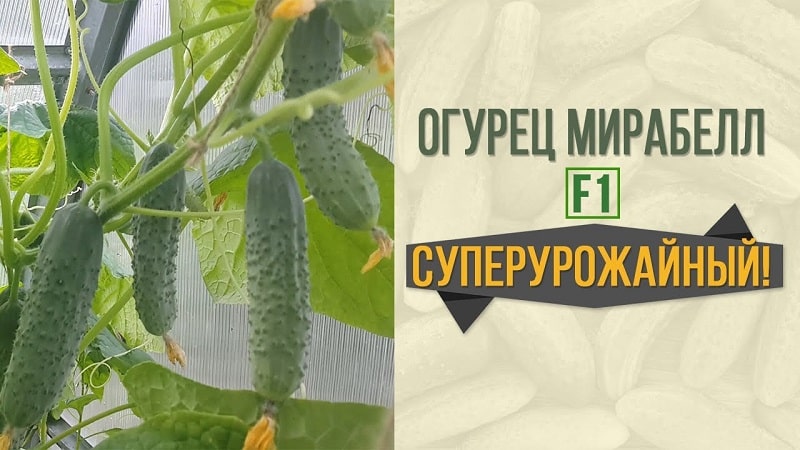
Distinctive features
Features of Mirabella:
- growing season - about 40 days;
- developed root system;
- up to 9 fruits are formed on one node at once;
- parthenocarpic hybrid (does not require pollination by bees);
- fruiting is long (until mid-September);
- high yield;
- resistance to major types of diseases.
Composition and properties
Nutritional value of fruits per 100 g:
- calorie content - 15 kcal;
- carbohydrates - 3 g;
- proteins - 0.9 g;
- fats - 0 g.
Cucumbers contain vitamins of group B, A, E, C, PP, micro- (iodine, fluorine, iron, zinc, selenium, copper) and macroelements (calcium, magnesium, sodium, potassium, phosphorus, chlorine), fiber.Regular consumption of vegetables normalizes the functioning of the digestive, cardiovascular, nervous, and immune systems. The alkali in the fruit stabilizes the acid-base balance.
Cucumbers are 95% water, which has a beneficial effect on the body's metabolic processes. The fruits have antioxidant effects, improve the condition of the skin and hair, and are useful for weight loss.
By the way! Canned cucumbers mostly retain their beneficial properties.
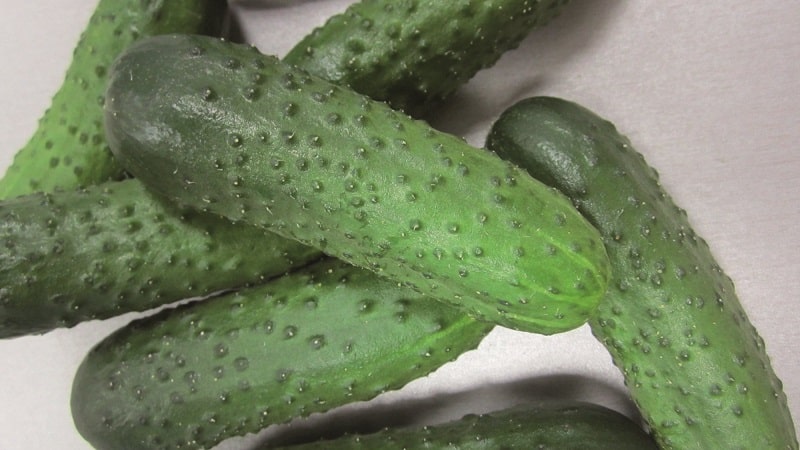
Characteristics
Vegetative type bushes with a well-developed root system. The stem reaches 5 m, the leaves are medium green. The initiation of ovaries is fascicular (6–8 fruits are formed). Cucumbers are 10-11 cm long, about 3 cm in diameter, weighing 70–90 g. The shape of the fruit is cylindrical, the skin is glossy dark green with medium tubercles, white pubescence. Seed germination is high, up to 100%.
The harvest ripens quickly and simultaneously: from 1 m2 remove up to 24 kg of cucumbers.
In the hybrid Mirabella noted high taste qualities: no bitterness, juicy pulp.
Other cucumber hybrids:
“Beam splendor”: grow in a greenhouse, open ground, on a windowsill
The domestic hybrid of cucumbers “Garland” pleases with a rich harvest
Early maturing hybrid of cucumbers “Bettina” for greenhouses and open ground
How to grow your own
The crop is cultivated both in greenhouses and in open ground, but the second method is preferable for the southern regions. They use the seedling method or direct sowing on the beds (in this case, the seeds are planted in early April, their germination rate is 1 out of 3).
Planting seeds and seedlings
For growing seedlings the seeds are wrapped in damp, warm gauze. When the first sprouts appear, the grains are planted in individual plastic or peat cups.Provide temperature conditions of +22…+28°С. As the top layer of soil dries, the crop is moistened with a spray bottle.
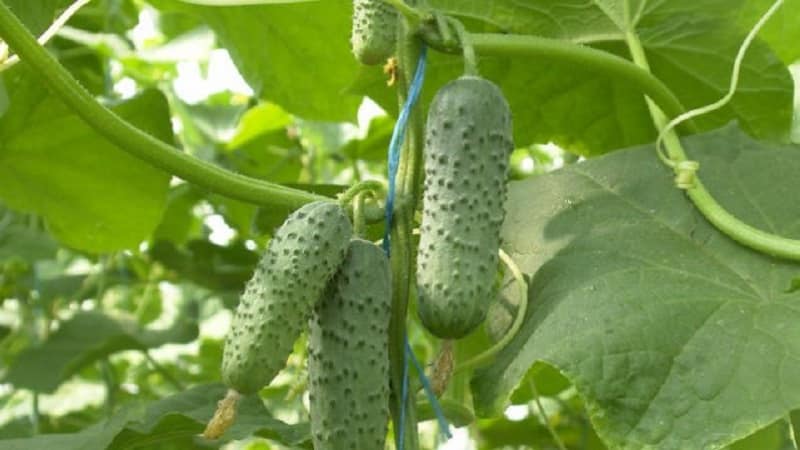
After 25–30 days, when up to 4 leaves have formed, the bushes dive into the garden. The approximate time of transplantation is mid-May. In open ground, cucumbers are transplanted to areas well lit by the sun and protected from the wind. When it gets colder, the picking is postponed.
Procedure for transplanting to a permanent place:
- Dig the soil shallowly.
- Using a hoe, dig shallow holes at a distance of 20 cm from each other.
- Moisten the soil in the cups and carefully remove the bushes.
- Move the sprouts along with a lump of earth into the prepared holes (treat them with a 1% solution of potassium permanganate) and cover them with soil on top.
- Water the plantings.
Important! The soil for the crop is prepared in advance: it is cleared of weeds and dug up along with peat. The best predecessors of cucumbers are cabbage, potatoes, onions, garlic, and beets.
Direct sowing into the ground is carried out when the soil warms up to +15°C. The seeds are buried 2 cm, maintaining intervals of 5 cm. The distance between the furrows is 50 cm. The soil is moistened from above.
Step-by-step cultivation and care
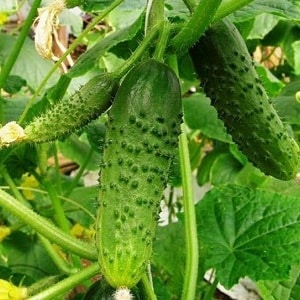 The hybrid is fed 4 times per season, alternating organics and minerals:
The hybrid is fed 4 times per season, alternating organics and minerals:
- 2 weeks after sowing or picking seedlings;
- during budding;
- at the fruiting stage;
- after the first harvest.
Water the cucumbers with warm water in the morning or evening., as the top layer of soil dries, but without waterlogging it. In hot weather, the bushes are irrigated daily. Make sure that the liquid does not get on the leaves and stems. When growing a hybrid in a greenhouse, it is regularly ventilated, but without drafts.
Cultivation care is standard and includes:
- weeding;
- loosening the soil between the bushes after each watering;
- mulching beds with sawdust and straw to better retain moisture and reduce weed growth.
Features of cultivation and possible difficulties
Mirabella is demanding on moisture - indoors the air humidity level is maintained at 80-90%. In summer, greenhouses are covered with shade nets and ventilated.
Frequent watering negatively affects the quality of fruits: they become watery and cannot withstand long-term storage and transportation.
Bushes form into 1 stem, the lashes are tied to the trellis as they grow.
Diseases and pests
Mirabella is resistant to cucumber mosaic viruses, powdery mildew and cladosporiosis, but quickly dies when frozen. Due to bad weather conditions (rain, excess sunlight), rusty spots may appear on the leaves.
Cucumbers are susceptible to pest attack:
- thin mites;
- thrips;
- aphids.
For prevention, bushes are treated in advance with insecticidal agents. (for example, "Aktellikom"). In open ground, protective equipment is used every 20 days, in greenhouses - 3 times with an interval of 3 days.
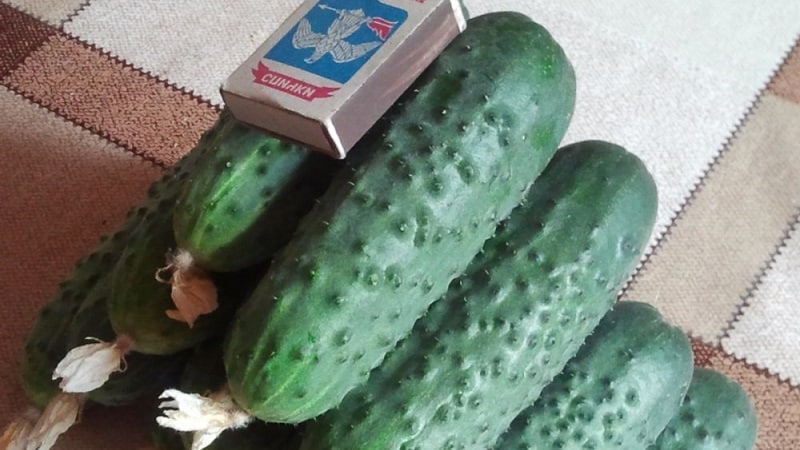
Harvesting and application
After planting in the garden, cucumbers are removed once a week, with mass fruiting - daily. Infrequent harvesting of vegetables leads to negative plant productivity.
The fruits are pickled, pickled, canned and fermented, and eaten fresh., added to vegetable salads. The harvest can be stored in the refrigerator for no more than a week.
Read also:
Hybrid cucumber “Uhazher” for growing in unfavorable conditions
Hybrid "Tchaikovsky f1", giving a rich harvest with minimal care
Advantages and disadvantages
Advantages of a hybrid:
 rapid ripening of the crop and constant fruiting;
rapid ripening of the crop and constant fruiting;- 100% germination;
- bunch formation of ovaries;
- versatility in cooking;
- self-pollination of plants;
- standard care;
- resistance to common diseases;
- high productivity.
However there is cons of culture:
- instability to frost;
- in the northern regions, cultivation is carried out only in greenhouses;
- poor resistance to rust and lack of immunity to pests;
- the need to garter bushes.
Reviews
Many gardeners speak about the characteristics of the Mirabella hybrid:
Regina, Moscow: “I have my own house and a small heated greenhouse. I tried many varieties of cucumbers, almost always some kind of problem arose: sometimes the germination rate is poor, sometimes they don’t pollinate and there are a lot of barren flowers, sometimes they get sick. That was until, on the advice of a friend, I bought Mirabella hybrid seeds. Its germination rate is almost 100%. There are practically no barren flowers, tasty fruits, without bitterness, and most importantly, the hybrid is resistant to diseases and does not require regular treatment for diseases.”.
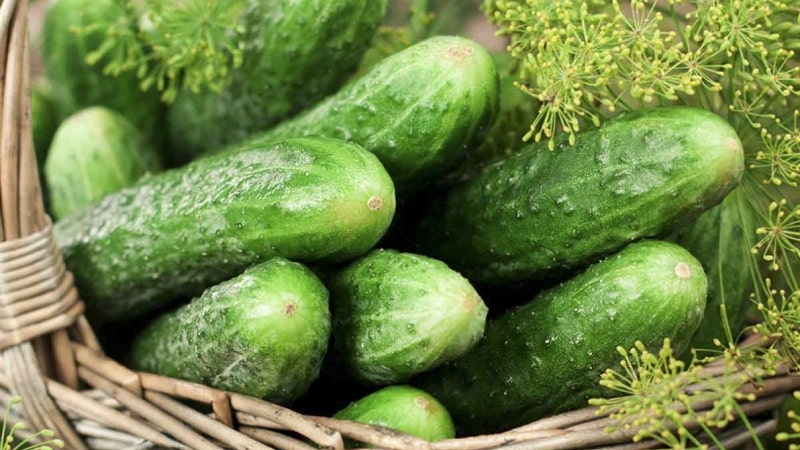
Stepan, Lugansk: “I’ll say right away that Mirabella is the same German that is loved by most gardeners. This is a parthenocarpic hybrid with early ripening, gherkin-type fruits. It can be grown both in greenhouses and in open ground. In one node it produces 7-8 ovaries. The bushes grow up to 15 cm. Cucumbers weighing up to 100 g are excellent for both salads and canning. Do not rush to sow the hybrid in open ground: wait for warmth and sufficient soil temperature. The plant will thank you for this with an early and abundant harvest.”.
Conclusion
Mirabella cucumbers are consistently popular among farmers. This hybrid is easy to care for, resistant to major diseases, and throughout the season produces a rich harvest of tasty and healthy fruits that are resistant to transportation and versatile in cooking.The disadvantages of the culture are weak immunity to pests and intolerance to frost.